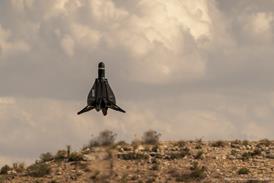Airbus aims to decide by around 2015 whether on-board fuel-cell technology can be matured sufficiently to negate the need for a ram air turbine (RAT) to be fitted to its next-generation, single-aisle replacement for the A320 airliner family.
Replacing the RAT with a fuel cell housed in an airliner's wing-body fairing would mark the first concrete step towards the European manufacturer's long-term goal of eliminating an airliner's gas-turbine auxiliary power unit.
German aerospace centre DLR exhibited at the show an A320 fuel cell demonstrator, which is equipped with an experimental 20kW AC fuel cell in the rear cargo hold. During its flight to Berlin the Michelin fuel cell was exposed to high loads for the first time, powering the A320's electric pump-driven "blue" hydraulic circuit and moving the ailerons and rudder.
"The little surprise we had was that the fuel cell was reacting more smoothly than expected to the higher ups and downs of the load," says Airbus vice-president environmental controls Thomas Scherer.
Airbus plans to conduct a ground test in which all systems required in an emergency scenario such as a double engine flame-out are powered by the fuel cell, but this is considered too risky to attempt in flight at this stage of the project.
"The idea is to prove it is possible to remove the RAT," says Scherer. "One of the advantages is that [a fuel cell] is more easy to test [than a RAT]. The fuel cell you can test without really powering up the system."
Scherer says an additional benefit is that the power available from the fuel cell is "higher at lower altitudes", where the output of the RAT declines as the aircraft's airspeed declines. This means that, for example, a fuel cell may supply sufficient power to extend the aircraft's trailing edge flaps during a glide-approach.
The weight of the fuel cell is "comparable" to that of a RAT, which weighs around 200kg (440lb) including its support structure, says Scherer. "By 2015 this technology might be ready to see service," he adds.
Following replacement of the RAT with an on-board fuel cell, Scherer envisages three further steps:
- A continuously running fuel cell producing oxygen-depleted exhaust gas for fuel-tank inerting, and water for passenger amenities.
- "That we can operate the aircraft on the ground without using kerosene." The fuel cell would be used to provide power for cabin air conditioning and the aircraft's electrical systems.
- Full replacement of the APU. This would require a dramatic improvement in the performance of fuel cells, as they currently produce around only one fortieth of the power output of a conventional APU.
Source: Flight International























